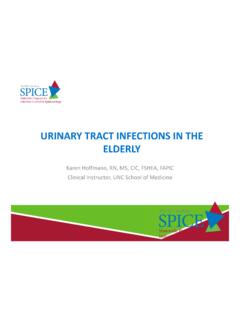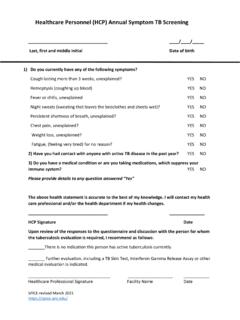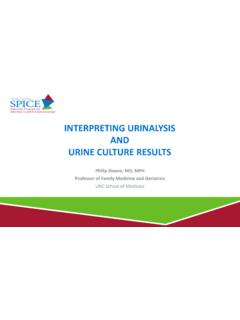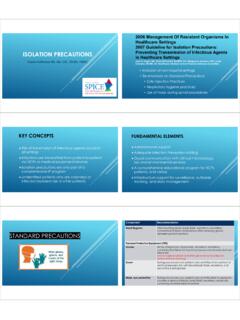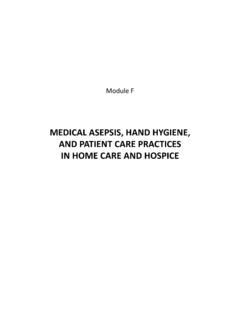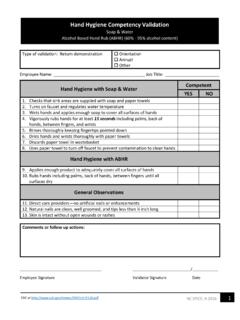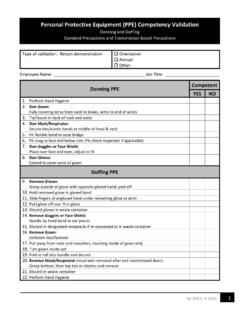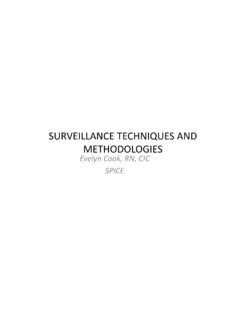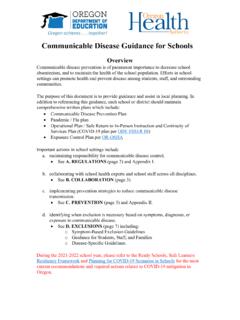Transcription of Infection Prevention, Outbreaks, and the Role of Public Health
1 Infection prevention , Outbreaks, and the Role of Public HealthJennifer MacFarquhar MPH, BSN, RN, CICC areer Epidemiology Field OfficerCenters for Disease Control and PreventionNC Division of Public Health Describe legal framework for communicable disease surveillance, investigation, and response Describe the SHARPPS Program Discuss when to call Public Health Review outbreak data Describe two outbreaks Discuss role of Public Health in Infection prevention and outbreak responseObjectivesPublic Health : Legal Framework Public Health Laws and Rules: General Statutes NC Administrative Code rules Health Director s Authority (State & Local) Surveillance Investigation Control MeasuresPublic Health LawGeneral Statutes 130A-144: Investigation and Control Measures(a) The local Health director shall cases of communicable diseases and communicable conditions reported to the local Health director(b) Physicians, persons in charge of medical facilities or laboratories, and other persons permit a local Health director or the State Health Director to examine, review, and obtain a copy of medical or other (d) The attending physician shall give control to a patient with a communicable disease or communicable condition and to patients reasonably suspected of being infected or exposed to such a disease or condition.
2 (e) The local Health director shall ensure that control have been given to prevent the spread of all reportable communicable diseases or communicable conditions and any other communicable disease or communicable condition that represents a significant threat to the Public Health . (f) All persons shall comply with control measures, including submission to examinations and Health Law10A NCAC 41A .0103: Duties of local Health director: report communicable diseases (a) Upon receipt of a report of a communicable disease or the local Health director shall:(1) immediately investigate the [to] include the collection and submission for laboratory examination of specimens necessary to assist in the diagnosis and indicate the duration of control measures;(2) determine what control measures have been given and ensure that proper control have been given and are being complied with;(c) Whenever an outbreak of a disease or condition occurs which is not required to be but which represents a significant threat to the Public Health , the local Health director shall give appropriate control and inform the Division of Public HealthPublic Health Law10A NCAC 41A.
3 0103: Duties of local Health director: report communicable diseases (a) Upon receipt of a report of a communicable disease or the local Health director shall:(1) immediately investigate the [to] include the collection and submission for laboratory examination of specimens necessary to assist in the diagnosis and indicate the duration of control measures;(2) determine what control measures have been given and ensure that proper control have been given and are being complied with;(c) Whenever an outbreak of a disease or condition occurs which is not required to be but which represents a significant threat to the Public Health , the local Health director shall give appropriate control and inform the Division of Public HealthPublic Health Law10A NCAC 41A .0101: Reportable diseases and conditions 74 reportable diseases and conditions Timeline of reporting varies between immediately and within 7 days Laboratory reporting requirementsResource: North Carolina Division of Public Health Communicable Disease ManualPublic Health Law 10A NCAC 41A.
4 0201 General Control Measures 10A NCAC 41A .0202 - .0205 Control Measures for HIV, Hepatitis B, STDs, TB 10A NCAC 41A .0206 Infection prevention Health Care Settings; 1992 Surveillance for Healthcare Associated and Resistant Pathogens Patient Safety (SHARPPS) ProgramJennifer MacFarquhar Program DirectorJames LewisMedical DirectorHeather DubendrisEpidemiologistKatie SteiderEpidemiologistSavannah CarricoEpidemiologistComing Soon!Epidemiology Program ManagerKristin PridgenHealth Educator, Campaigns CoordinatorNC SHARPPS ProgramMissionTo work in partnerships to prevent, detect, and respond to events and outbreaks of healthcare-associated and antimicrobial resistant infections in North , Investigation & ResponsePrevention, Education & TrainingMonitoring & EvaluationCommunicationHAI reporting to NHSNCRE surveillanceDHSR Infection prevention Breach reportingOutbreak & Exposure managementCampaignsDrug DiversionAntimicrobial resistance & stewardship Infection Control, Assessment & Response (ICAR)PartnershipsData validationTAP reportsIdentification, evaluation of aberrant data (CLABSI, CDI)
5 HAI data reports NewslettersMonthly webinar updatesDrug Diversion tabletopSHARPPS Program ActivitiesSurveillance, Investigation & ResponsePrevention, Education & TrainingMonitoring & EvaluationCommunicationHAI reporting to NHSNCRE surveillanceDHSR Infection prevention Breach reportingOutbreak & Exposure managementCampaignsDrug DiversionAntimicrobial resistance & stewardship Infection Control, Assessment & Response (ICAR)PartnershipsData validationTAP reportsIdentification, evaluation of aberrant data (CLABSI, CDI)HAI data reports NewslettersMonthly webinar updatesDrug Diversion tabletopSHARPPS Program ActivitiesOutbreak Investigations Primary responsibility of Public Health 199 outbreaks reported to NC DPH in 2016 4,302+ outbreak-associated cases identifiedOutbreak Investigations Primary responsibility of Public Health 199 outbreaks reported to NC DPH in 2016 4,302+ outbreak-associated cases identifiedOutbreak Investigations Primary responsibility of Public Health 199 outbreaks reported to NC DPH in 2016 4,302+ outbreak-associated cases identifiedWhen Should Public Health Be Called?
6 Reportable diseases (10A NCAC 41A .0101) When anydisease is above normal baseline ( an outbreak ) Report suspected Infection prevention breachWhen Is It An Outbreak? Anything above what is normally seen for any given time period If you aren t sure, call Public Health ! In a facility setting, an outbreak is generally defined as two or more individuals with the same illness Caveat to this rule: One case of certain diseases = Outbreak Disease not normally seen (Avian Flu, SARS, Ebola)What Happens After Public Health Is Called? Data review Clinical investigation: Case finding looking for others who are or who have been ill Interviews, specimen collection, testing Environmental investigation Control measures Assist with patient/family/ Public information if neededPublic Health Role in Safe Injection PracticesSafe Injection Practices Measures taken to perform injections in a safe manner for patients and providers Prevent transmission of infectious diseases from.
7 Patient to provider Provider to patient Patient to patient Bloodborne pathogens Hepatitis B (HBV) Hepatitis C (HCV) Human Immunodeficiency Virus (HIV) Health Role in Safe Injection Practices Raise awareness of safe injection practices and eradicate outbreaks resulting from unsafe injection practices Collaborative efforts Forging new partnerships Safe injection education for licensed professionals Investigate outbreaks of disease related to unsafe injection practices Unsafe Injection Practices: Causes1. Syringe reuse (direct and indirect)2. Misuse of single-dose/single-use vials3. Failure to use aseptic technique4. Unsafe diabetes care5. Drug DiversionNorth Carolina Hepatitis Outbreaks, Non-Hospital Settings SettingYearTypeNo. Incident InfectionsCardiology 2008 HCV5 ALF2010 HBV8 SNF2010 HBV6 SNF2010 HBV6 Dialysis2013 HBV1 Total26 Drug Diversion When prescription medicines are obtained or used illegally Becoming so pervasive that CDC has formally labeled it an "epidemic" 6 HCV outbreaks linked to drug diversion by infected Health care providers, 1983 2015 5 hospitals and 1 ambulatory surgery center >144 new infections linked to these outbreaks 4 bacterial outbreaks 63.
8 Tuesday, October 12, 2010 County Health department notified by Infection preventionist at local hospital 4 cases of acute hepatitis Residents of the same assisted living facilityInvestigation Methods Evaluated Infection control practices Observations Interviews Searched for additional cases Serologic testing of all residents Hospital records, surveillance databases Epidemiologic study Potential healthcare exposures, risk factorsHBV Outbreak in Assisted Living FacilityCases identified8 Mean yearsHospitalized8 (100%)Died6 (75%) Health Care ExposuresAttack rate (%)ExposureExposedNot exposedAssisted BGM8/15 (53)0/25 (0)Injected medication4/16 (25)4/22 (18)Phlebotomy4/25 (16)4/15 (27)Blood transfusion0/1 (0)8/38 (21)Catheter device0/3 (0)8/37 (22)Wound care1/8 (13)6/28 (21) Infection Control Observations Glucose meters: Used for more than one resident Not disinfected between uses Adjustable lancing devices: Used for more than one residentRecommendations to Facility Use single-use disposable lancets Purchase and use individual glucose meters for each resident Vaccinate all susceptible residentsDirect Communication to Providers Sent to all licensed facilities and providers statewide Act to Protect Adult Care Home Residents Signed into law May 31st, 2011 Requires.
9 Stronger Infection prevention policies Inspection and monitoring of Infection prevention activities Reporting of suspected outbreaks Increased training and competency evaluation for medication aides, adult care home supervisorsNew Reporting required by CMSS urveyors must report to StateInfection prevention BreachesPublic Health Role in Multidrug-Resistant Organisms (MDROs)Multidrug-resistant Organisms (MDROs) Resistant to several kinds of drugs Intra- and inter-facility spread Vulnerable patients at risk for Infection Infections are difficult to treat and can be associated with high mortality rates Examples: MRSA, CRE, ESBLP ublic Health Significance Spread facilitated by interfacility transfer of patients Affects vulnerable patient populations Difficult to treat Improper treatment some organisms may produce another enzyme that makes it easier to transmit resistanceInvestigation Notified by LHD on April 21, 2017 (a Friday!)
10 Increase in the number infections caused by a specific MDRO among patients admitted to local hospital between October 16, 2016 and April 13, 2017 Majority of cases were residents of three long-term care facilities (LTCFs) Coordinated an investigation to: assess Infection prevention practices among these LTCFs, and prevent further intra- and inter- facility spread of disease 4 cases were discussed on Friday but > 40 positive labs were waiting for us on Monday morning! Initial Control MeasuresGown and glovesPrevent opportunities for transmissionHand hygiene Site Visit Findings Hand hygiene: inconsistent Wound care: reusing scissors, interruptions in flow from clean to dirty OT/PT: contact precautions not adequately maintained, lack of dedicated equipment Contact precautions: implemented to varying degrees Lack of inter-facility notification Outdated policiesControl Measures1.


